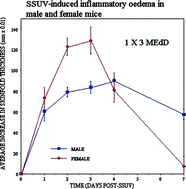 New insights into mechanisms behind gender differences in skin cancer development are revealed in this article from Vivienne Reeve and co-workers from Sydney, Australia. A contributing factor for skin cancer development in mice and humans is immunosuppression as a result of UVB light; whilst the contribution of UVA is controversial it has been shown to antagonise immunosuppression by UVB. One of the mechanisms for this UVA protection which has been demonstrated in mice is mediated via oestrogen receptor-β signalling, suggesting a gender bias in photoimmune response to UVA.
New insights into mechanisms behind gender differences in skin cancer development are revealed in this article from Vivienne Reeve and co-workers from Sydney, Australia. A contributing factor for skin cancer development in mice and humans is immunosuppression as a result of UVB light; whilst the contribution of UVA is controversial it has been shown to antagonise immunosuppression by UVB. One of the mechanisms for this UVA protection which has been demonstrated in mice is mediated via oestrogen receptor-β signalling, suggesting a gender bias in photoimmune response to UVA.
Gender bias is tested in this study by comparing the UV-induced inflammatory and immune responses in male and female hairless mice. The study uses solar simulated radiation (SSUV) to induce sunburn, the resulting inflammatory oedema is measured through the increase in irradiated skinfold thickness and levels of the pro-inflammatory cytokine interleukin (IL)-6 in the epidermis. Immune function was assessed by the contact hypersensitivity (CHS) reaction and its suppression by SSUV was related to the level of expression of the immunosuppressive cytokine IL-10 in the epidermis.
Results showed that although male mice had less intense sunburn with lower expression of IL-6 the CHS reaction was more severely suppressed by SSUV than females and this also correlated with increased epidermal expression of immunosuppressive IL-10. Exposure to UVB alone had equal effects in male and female mice, however, UVA irradiation induced immunoprotection in females but this effect was reduced or not present in males. The results indicate that males have a relative unresponsiveness to the photoimmune protective effects of UVA. This could explain the known gender bias in skin cancer development in both mice and humans.
Interested in knowing more? Read the full article here. Free until 4th November.
Gender differences in UV-induced inflammation and immunosuppression in mice reveal male unresponsiveness to UVA radiation
Vivienne E. Reeve, Munif Allanson, Diane Domanski and Nicole Painter
Photochem. Photobiol. Sci., 2011, DOI: 10.1039/C1PP05224A










